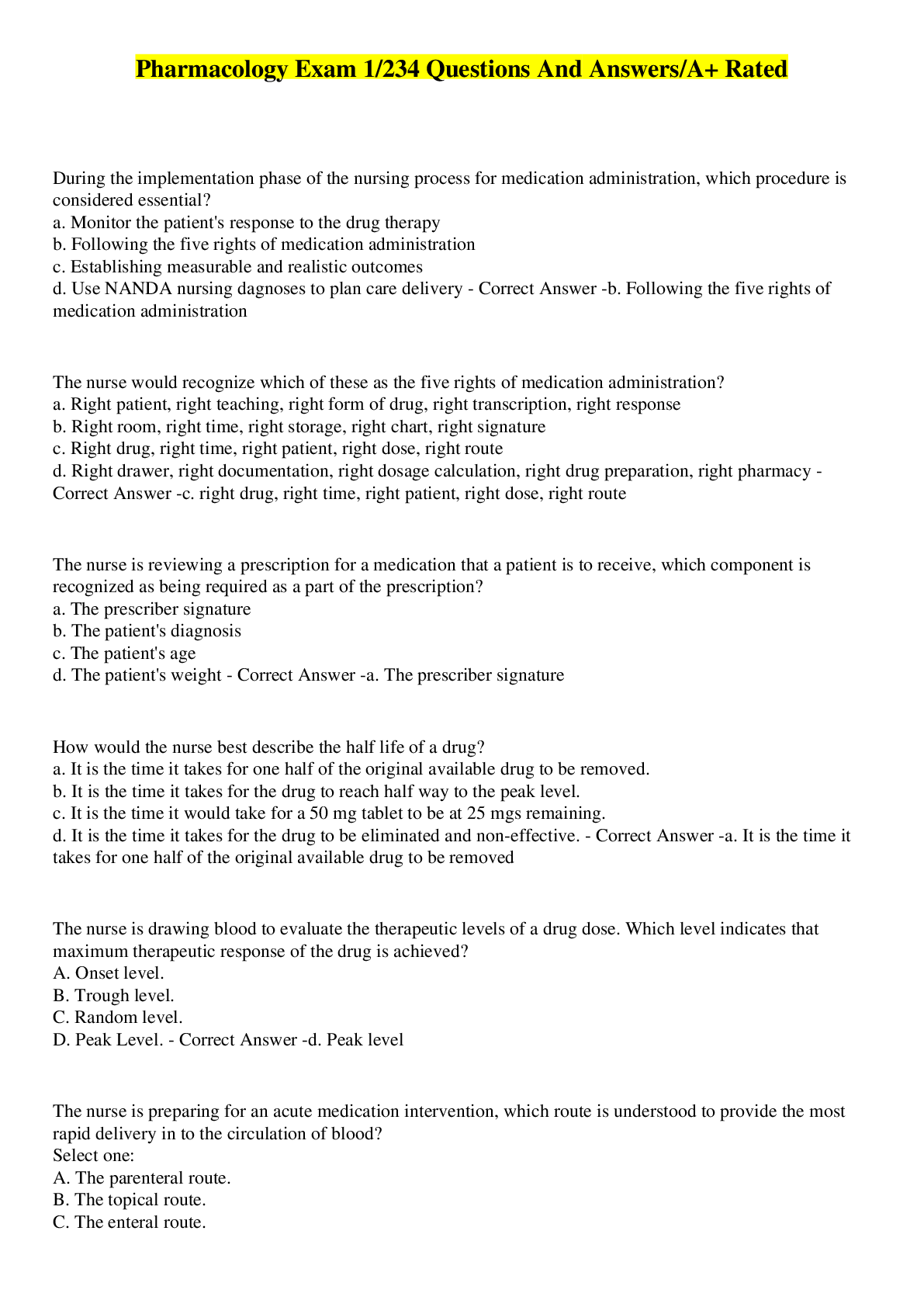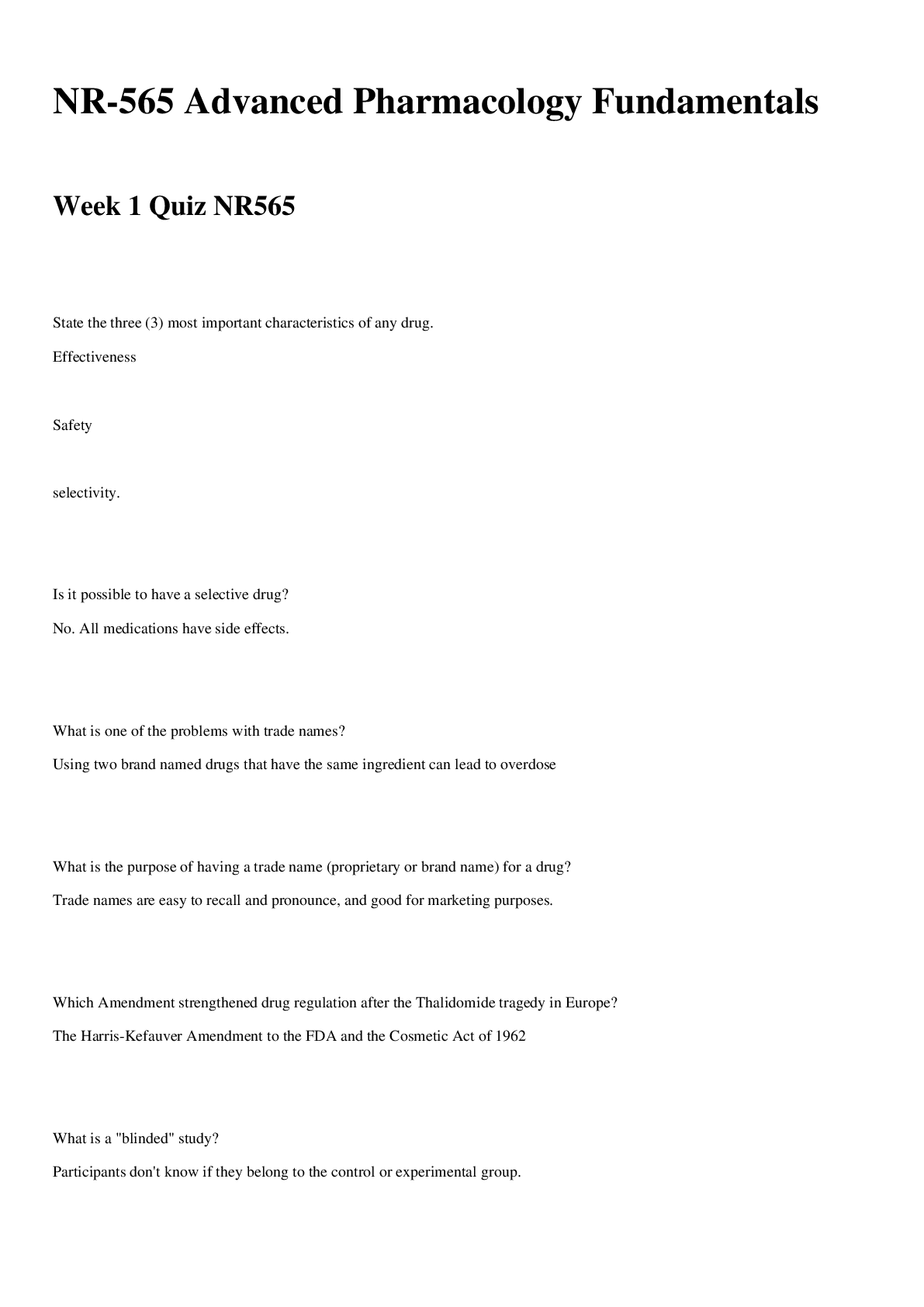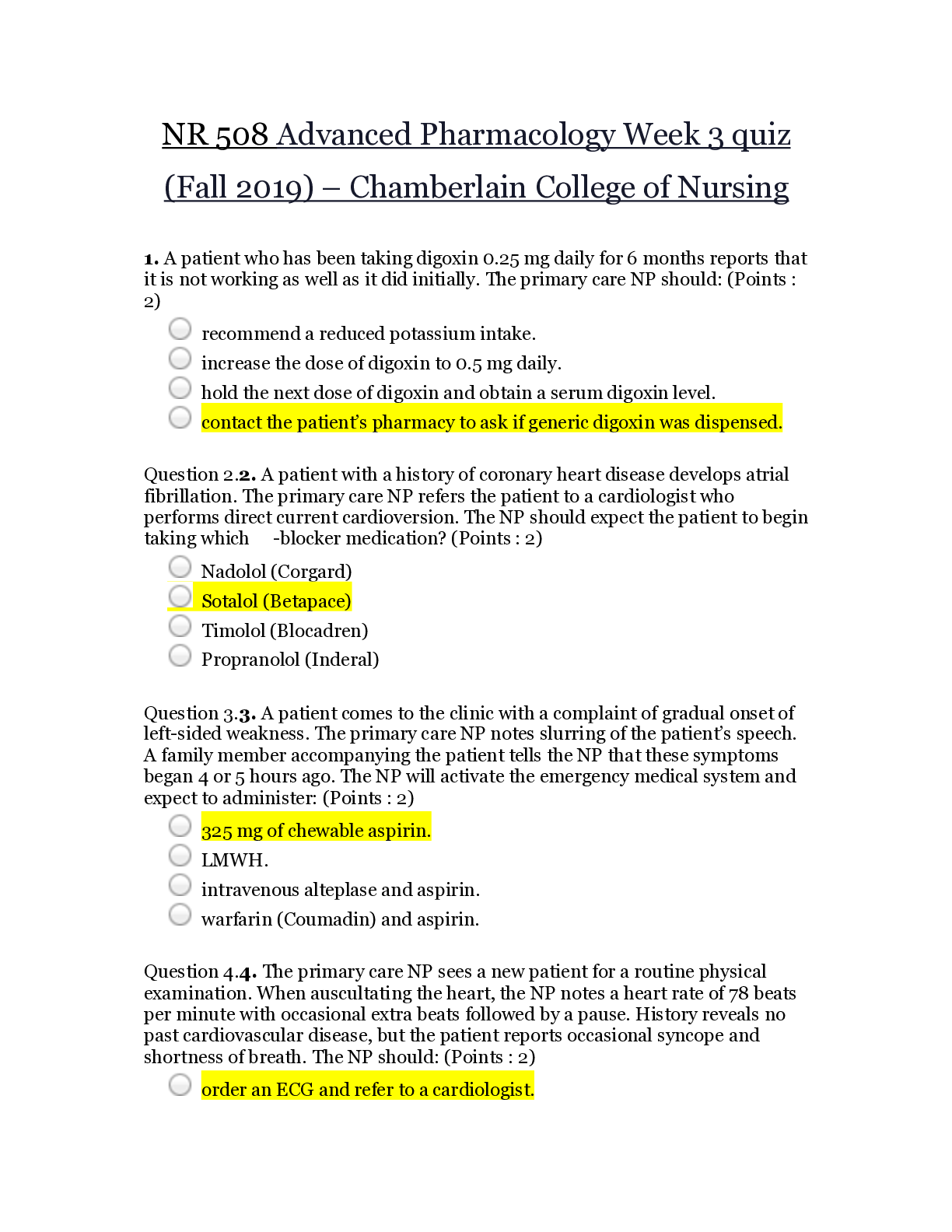*NURSING > EXAM > NR 509 Physical Assessment Quiz 1 (2020) – Chamberlain College of Nursing | NR509 Physical Assessm (All)
NR 509 Physical Assessment Quiz 1 (2020) – Chamberlain College of Nursing | NR509 Physical Assessment Quiz 1 (2020)
Document Content and Description Below
NR 509 Physical Assessment Quiz 1 (2020) – Chamberlain College of Nursing Physical Assessment Quiz 1 1. Question : The nurse is performing a physical assessment on a newly admitted p... atient. An example of objective information obtained during the physical assessment includes the Student Answer: patient’s history of allergies. patient’s use of medications at home. last menstrual period one month ago. 2 5 cm scar present on the right lower forearm. Instructor Explanation: Objective data are the patient’s record, laboratory studies, and information that the health professional observes by inspecting, percussing, palpating, and auscultating during the physical examination. The other responses reflect subjective data. Points Received: 2 of 2 Comments: Question 2. Question : Barriers to incorporating evidence-based practice (EBP) include Student Answer: nurses’ lack of research skills in evaluating quality of research studies. lack of significant research studies. insufficient clinical skills of nurses. inadequate physical assessment skills. Instructor Explanation: As individuals, nurses lack research skills in evaluating quality of research studies, are isolated from other colleagues who are knowledgeable in research, and lack time to go to the library to read research. The other responses are not considered barriers. Points Received: 2 of 2 Comments: Question 3. Question : The nurse has implemented several planned interventions to address the nursing diagnosis of acute pain. Which would be the next appropriate action? Student Answer: Establish priorities. Identify expected outcomes. Evaluate the individual’s condition and compare actual outcomes with expected outcomes. Interpret data and then identify clusters of cues and make inferences. Instructor Explanation: Evaluation is the next step after the implementation phase of the nursing process. During this step, the nurse should evaluate the individual’s condition and compare actual outcomes with expected outcomes. Points Received: 2 of 2 Comments: Question 4. Question : Which of these would be formulated by a nurse using diagnostic reasoning? Student Answer: Nursing diagnosis Medical diagnosis Diagnostic hypothesis Diagnostic assessment Instructor Explanation: Diagnostic reasoning calls for the nurse to formulate a diagnostic hypothesis; the nursing process calls for a nursing diagnosis. Points Received: 2 of 2 Comments: Question 5. Question : The nurse asks, “I would like to ask you some questions about your health and your usual daily activities so that we can better plan your stay here.” This question is found at the _____ phase of the interview process. Student Answer: summary closing body opening or introduction Instructor Explanation: When gathering a complete history, the nurse should give the reason for the interview during the opening or introduction of the interview, not during or at the end of the interview. Points Received: 2 of 2 Comments: Question 6. Question : A female nurse is interviewing a male patient who is near the same age as the nurse. During the interview, the patient makes an overtly sexual comment. The nurse’s best reaction would be Student Answer: “Stop that immediately!” “Oh, you are too funny. Let’s keep going with the interview.” “Do you really think I would be interested?” “It makes me uncomfortable when you talk that way. Please stop.” Instructor Explanation: The nurse’s response must make it clear that she is a health professional who can best care for the person by maintaining a professional relationship. At the same time, the nurse should communicate that he or she accepts the person and understands the person’s need to be self-assertive but that sexual advances cannot be tolerated. Points Received: 2 of 2 Comments: Question 7. Question : The nurse makes this comment to a patient: “I know it may be hard, but you should do what the doctor ordered because she is the expert in this field.” Which statement is correct about the nurse’s comment? Student Answer: This comment is inappropriate because it shows the nurse’s bias. This comment is appropriate because members of the healthcare team are experts in the area of patient care. This type of comment promotes dependency and inferiority on the part of the patient and is best avoided in an interview situation. At times, it is necessary to use authority statements when dealing with patients, especially when they are undecided about an issue. Instructor Explanation: Using authority responses promotes dependency and inferiority. It is best to avoid using authority. Although the healthcare provider and patient do not have equal professional knowledge, both have equally worthy roles in the health process. The other statements are not correct. Points Received: 2 of 2 Comments: Question 8. Question : A patient has finished giving the nurse information about the reason he is seeking care. When reviewing the data, the nurse finds that some information about past hospitalizations is missing. At this point, which statement by the nurse would be most appropriate to gather these data? Student Answer: “Mr. Y., at your age, surely you have been hospitalized before!” “Mr. Y., I just need permission to get your medical records from County Medical.” “Mr. Y., you mentioned that you have been hospitalized on several occasions. Would you tell me more about that?” “Mr. Y., I just need to get some additional information about your past hospitalizations. When was the last time you were admitted for chest pain?” Instructor Explanation: The nurse should use direct questions after the person’s opening narrative to fill in any details he or she left out. The nurse also should use direct questions when specific facts are needed, such as when asking about past health problems or during the review of systems. Points Received: 2 of 2 Comments: Question 9. Question : The nurse is incorporating a person’s spiritual values into the health history. Which of these questions illustrates the “community” portion of the FICA questions? Student Answer: “Do you believe in God?” “Are you a part of any religious or spiritual congregation?” “Do you consider yourself to be a religious or spiritual person?” “How does your religious faith influence the way you think about your health?” Instructor Explanation: The “community” is assessed when the nurse asks whether a person is part of a religious or spiritual community or congregation. The other areas assessed are faith, influence, and addressing any religious or spiritual issues or concerns. Points Received: 2 of 2 Comments: Question 10. Question : The nurse is performing a review of symptoms. Which of these questions is appropriate as health promotion questions to ask during this time? Student Answer: “Do you use sunscreen while outside?” “May I see if your skin is warm and dry?” “Have you had any dizziness or headaches?” “When you cough, what color is the sputum you bring up?” Instructor Explanation: The review of symptoms is not a record of physical findings or subjective or objective data. The use of sunscreen is a health promotion item. Points Received: 2 of 2 Comments: Question 11. Question : The nurse is obtaining a history from a 30-year-old male patient and is concerned about health promotion activities. Which of these questions would be appropriate to use to assess health promotion activities for this patient? Student Answer: “Do you perform testicular self-examinations?” “Have you ever noticed any pain in your testicles?” “Have you had any problems with passing urine?” “Do you have any history of sexually transmitted disease?” Instructor Explanation: Health promotion for a man would include performance of testicular self-examinations. The other questions are asking about possible disease or illness issues. Points Received: 2 of 2 Comments: Question 12. Question : A 5-year-old boy is being admitted to the hospital to have his tonsils removed. Which information should the nurse collect before this procedure? Student Answer: The child’s birth weight The age at which he crawled Whether he has had the measles Reactions to previous hospitalizations Instructor Explanation: Assess how the child reacted to hospitalization and any complications. If the child reacted poorly, he or she may be afraid now and will need special preparation for the examination that is to follow. The other items are not significant for the procedure. Points Received: 2 of 2 Comments: Question 13. Question : A female patient tells the nurse that she has had six pregnancies, with four live births at term and two spontaneous abortions. Her four children are still living. How would the nurse record this information? Student Answer: P-6, B-4, (S)Ab-2 Grav 6, Term 4, (S)Ab 2, Living 4 Patient has had four living babies. Patient has been pregnant six times. Instructor Explanation: Obstetric history includes the number of pregnancies (gravidity), number of deliveries in which the fetus reached term (term), number of preterm pregnancies (preterm), number of incomplete pregnancies (abortions), and number of children living (living). This is recorded: Grav _____ Term _____ Preterm _____ Ab _____ Living _____. For any incomplete pregnancies, record the duration and whether the pregnancy resulted in spontaneous (S) or induced (I) abortion. Points Received: 2 of 2 Comments: Question 14. Question : The nurse is preparing to use an otoscope for an examination. Which statement is true regarding the otoscope? The otoscope Student Answer: is often used to direct light onto the sinuses. uses a short, broad speculum to help visualize the ear. is used to examine the structures of the internal ear. directs light into the ear canal and onto the tympanic membrane. Instructor Explanation: The otoscope directs light into the ear canal and onto the tympanic membrane that divides the external and middle ear. A short, broad speculum is used to visualize the nares. Points Received: 2 of 2 Comments: Question 15. Question : Which of these statements is true regarding the use of standard precautions in the healthcare setting? Student Answer: Standard precautions apply to all body fluids, including sweat. Use alcohol-based hand rub if hands are visibly dirty. Standard precautions are intended for use with all patients regardless of their risk or presumed infection status. Standard precautions are to be used only when there is nonintact skin, excretions containing visible blood, or expected contact with mucous membranes. Instructor Explanation: Standard precautions are designed to reduce the risk of transmission of microorganisms from both recognized and unrecognized sources. They are intended for use for all patients, regardless of their risk or presumed infection status. They apply to blood and all other body fluids, secretions, and excretions except sweat—regardless of whether they contain visible blood, nonintact skin, or mucous membranes. Hands should be washed with soap and water if visibly soiled with blood or body fluids; alcohol-based handrubs can be used if hands are not visibly soiled. Points Received: 2 of 2 Comments: Question 16. Question : Which of these techniques uses the sense of touch to assess texture, temperature, moisture, and swelling when the nurse is assessing a patient? Student Answer: Palpation Inspection Percussion Auscultation Instructor Explanation: Palpation uses the sense of touch to assess the patient for these factors. Inspection involves vision; percussion assesses through the use of palpable vibrations and audible sounds; and auscultation uses the sense of hearing. Points Received: 2 of 2 Comments: Question 17. Question : A man is at the clinic for a physical examination. He states that he is “very anxious” about the physical examination. What steps can the nurse take to make him more comfortable? Student Answer: Appear unhurried and confident when examining him. Stay in the room when he undresses in case he needs assistance. Ask him to change into an examining gown and take off his undergarments. Defer measuring vital signs until the end of the examination, which allows him time to become comfortable. Instructor Explanation: Anxiety can be reduced by an examiner who is confident, self-assured, considerate, and unhurried. Familiar and relatively nonthreatening actions, such as measuring the person’s vital signs, will gradually accustom the person to the examination. Points Received: 2 of 2 Comments: Question 18. Question : The nurse is preparing to use a stethoscope for auscultation. Which statement is true regarding the diaphragm of the stethoscope? The diaphragm Student Answer: is used to listen for high-pitched sounds. is used to listen for low-pitched sounds. should be held lightly against the person’s skin to block out low-pitched sounds. should be held lightly against the person’s skin to listen for extra heart sounds and murmurs. Instructor Explanation: The diaphragm of the stethoscope is best for listening to high-pitched sounds such as breath, bowel, and normal heart sounds. It should be held firmly against the person’s skin, firmly enough to leave a ring. The bell of the stethoscope is best for soft, low-pitched sounds such as extra heart sounds or murmurs. Points Received: 2 of 2 Comments: Question 19. Question : The nurse knows that one advantage of the tympanic thermometer is that Student Answer: its rapid measurement is useful for uncooperative younger children. it is the most accurate method for measuring temperature in newborn infants. it is an inexpensive means of measuring temperature. studies strongly support use of the tympanic route in children under age six years. Instructor Explanation: The tympanic thermometer (TMT) is useful for younger children who may not cooperate for oral temperatures and fear rectal temperatures. Keep in mind that TMT use with newborn infants and young children is conflicting. Points Received: 2 of 2 Comments: Question 20. Question : The nurse is conducting a health fair for older adults. Which statement is true regarding vital sign measurements in aging adults? Student Answer: The pulse is more difficult to palpate because of the stiffness of the blood vessels. An increased respiratory rate and a shallower inspiratory phase are expected findings. A decreased pulse pressure occurs from changes in systolic and diastolic blood pressures. Changes in the body’s temperature regulatory mechanism leave the aging person more likely to develop a fever. Instructor Explanation: Aging causes a decrease in vital capacity and decreased inspiratory reserve volume. The examiner may notice a shallower inspiratory phase and an increased respiratory rate. An increase in the rigidity of arterial walls makes the pulse actually easier to palpate. Pulse pressure is widened in older adults, and changes in the body temperature regulatory mechanism leave the aging person less likely to have fever, but at a greater risk for hypothermia. Points Received: 2 of 2 Comments: Question 21. Question : The nurse is taking an initial blood pressure on a 72-year-old patient with documented hypertension. How should the nurse proceed? Student Answer: Place the cuff on the patient’s arm and inflate it 30 mm Hg above the patient’s pulse rate. Inflate the cuff to 200 mm Hg in an attempt to obtain the most accurate systolic reading. Inflate the blood pressure cuff 30 mm Hg above the point at which the palpated pulse disappears. Look at the patient’s past blood pressure readings and inflate the cuff 30 mm Hg above the highest systolic reading recorded. Instructor Explanation: An auscultatory gap occurs in about 5% of the people, most often in those with hypertension. To check for the presence of an auscultatory gap, inflate the cuff 20 to 30 mm Hg beyond the point at which the palpated pulse disappeared. Points Received: 2 of 2 Comments: Question 22. Question : The nurse is examining a patient who is complaining of “feeling cold.” Which is a mechanism of heat loss in the body? Student Answer: Exercise Radiation Metabolism Food digestion Instructor Explanation: The body maintains a steady temperature through a thermostat, or feedback mechanism, regulated in the hypothalamus of the brain. The hypothalamus regulates heat production (from metabolism, exercise, food digestion, and external factors) with heat loss (through radiation, evaporation of sweat, convection, and conduction). Points Received: 2 of 2 Comments: Question 23. Question : When measuring a patient’s weight, the nurse keeps in mind which of these guidelines? Student Answer: Always weigh the patient with only his or her undergarments on. It does not matter what type of scale is used, as long as the weights are similar from day-to-day. The patient may leave on his or her jacket and shoes as long as this is documented next to the weight. Attempt to weigh the patient at approximately the same time of day, if a sequence of weights is necessary. Instructor Explanation: A standardized balance scale is used to measure weight. The patient should remove his or her shoes and heavy outer clothing. If a sequence of repeated weights is necessary, then the nurse should aim for approximately the same time of day and type of clothing worn each time. Points Received: 2 of 2 Comments: Question 24. Question : The nurse knows that which statement is true regarding the pain experienced by infants? Student Answer: Pain in infants can only be assessed by physiologic changes, such as increased heart rate. The Faces Pain Scale—revised (FPS-R) can be used to assess pain in infants. A procedure that induces pain in adults will also induce pain in the infant. Infants feel pain less than adults do. Instructor Explanation: If a procedure or disease process causes pain in an adult, then it will also cause pain in an infant. Physiologic changes cannot be used exclusively to confirm or deny pain because other factors, such as medications, fluid status, or stress may cause physiologic changes. The Faces Pain Scale—Revised can be used starting at around age 4 years. Points Received: 2 of 2 Comments: Question 25. Question : A patient is complaining of severe knee pain after twisting it during a basketball game and is requesting pain medication. Which action by the nurse is appropriate? Student Answer: Complete the physical examination first and then give the pain medication. Tell the patient that the pain medication must wait until after the x-rays are completed. Evaluate full range of motion of the knee and then medicate for pain. Administer pain medication and then proceed with the assessment. Instructor Explanation: According to the American Pain Society (1992), “In cases in which the cause of acute pain is uncertain, establishing a diagnosis is a priority, but symptomatic treatment of pain should be given while the investigation is proceeding. With occasional exceptions, (e.g., the initial examination of the patient with an acute condition of the abdomen), it is rarely justified to defer analgesia until a diagnosis is made. In fact, a comfortable patient is better able to cooperate with diagnostic procedures.” [Show More]
Last updated: 1 year ago
Preview 1 out of 16 pages
 – Chamberlain College of Nursing.png)
Reviews( 0 )
Document information
Connected school, study & course
About the document
Uploaded On
Aug 16, 2020
Number of pages
16
Written in
Additional information
This document has been written for:
Uploaded
Aug 16, 2020
Downloads
0
Views
69














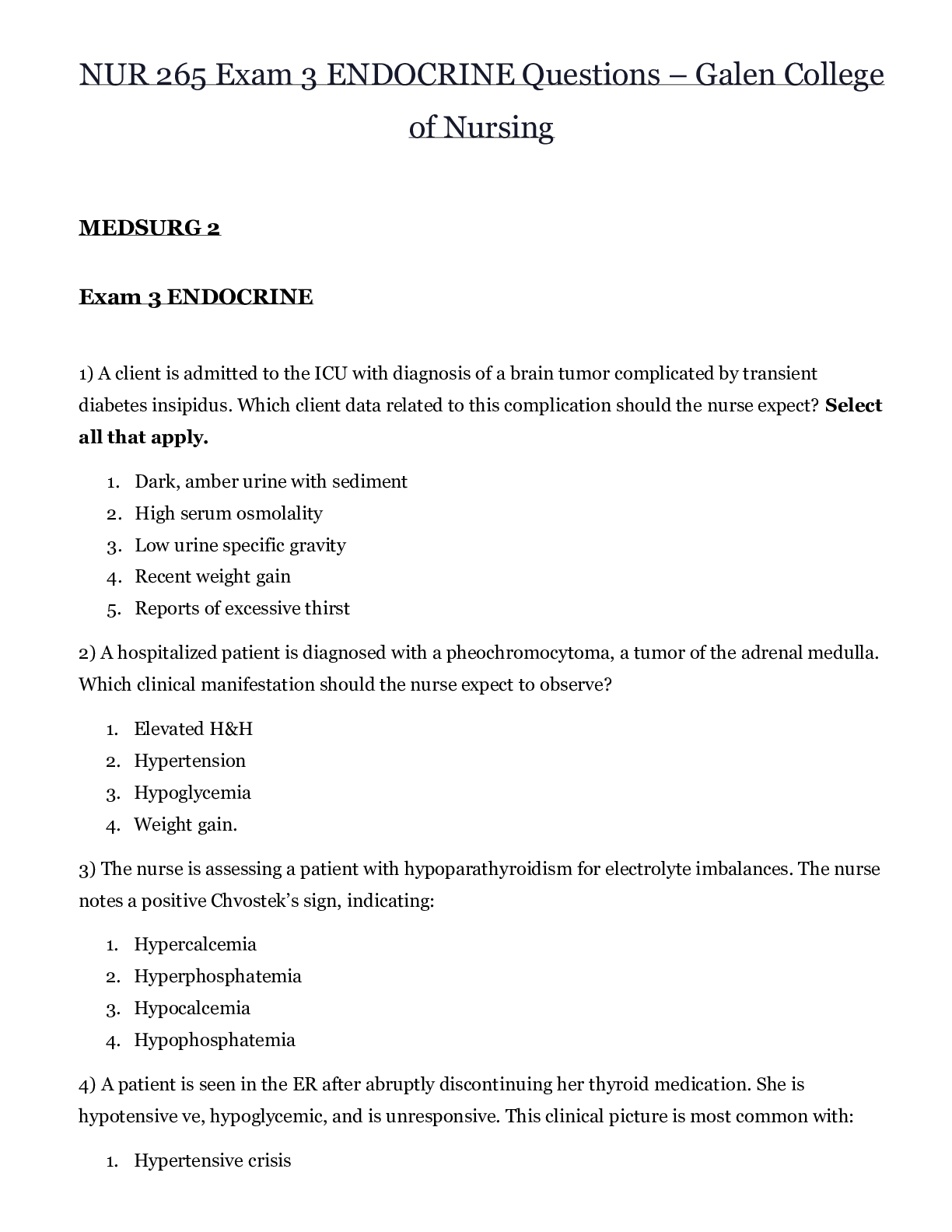
 – CHAMBERLAIN COLLEGE OF NURSING.png)
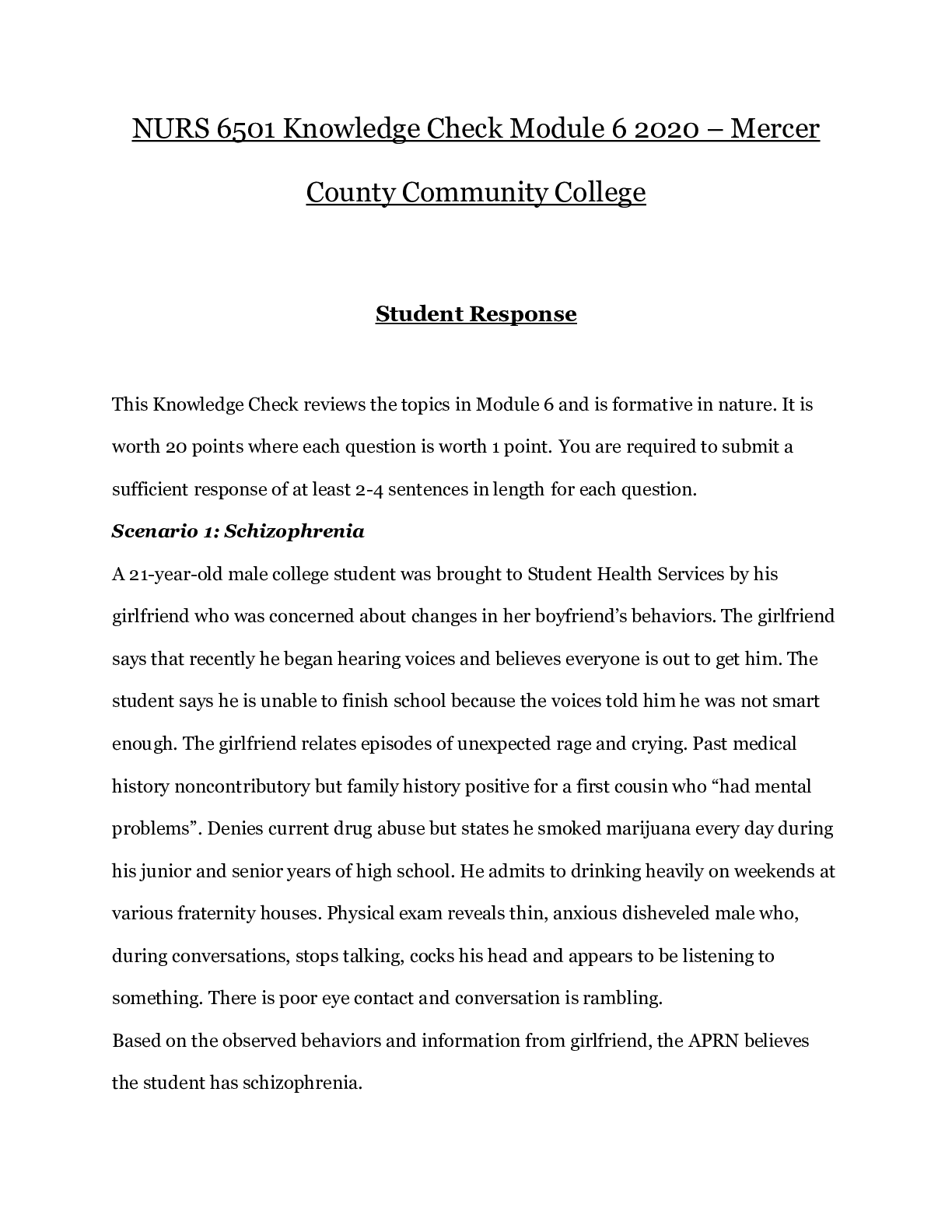


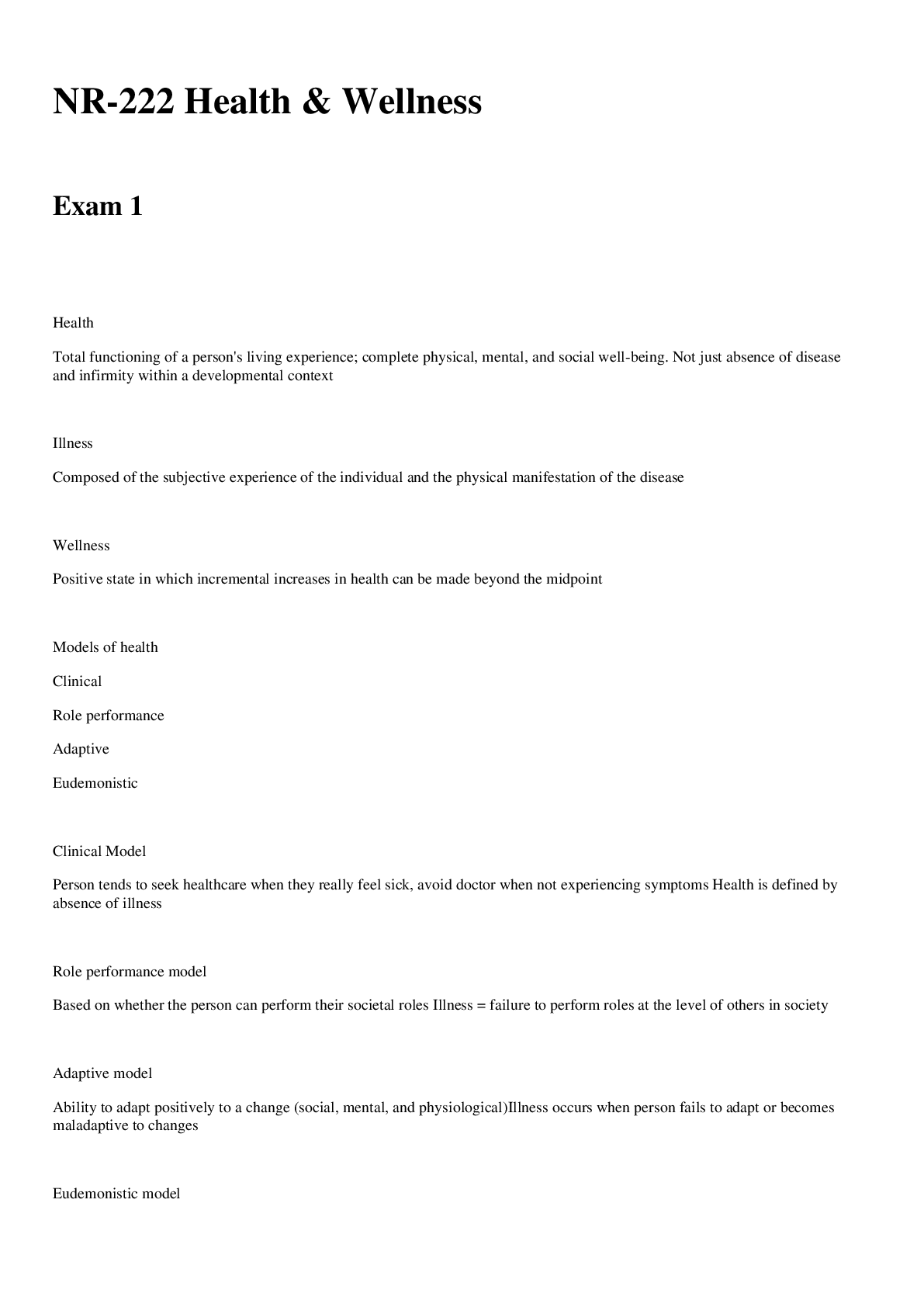



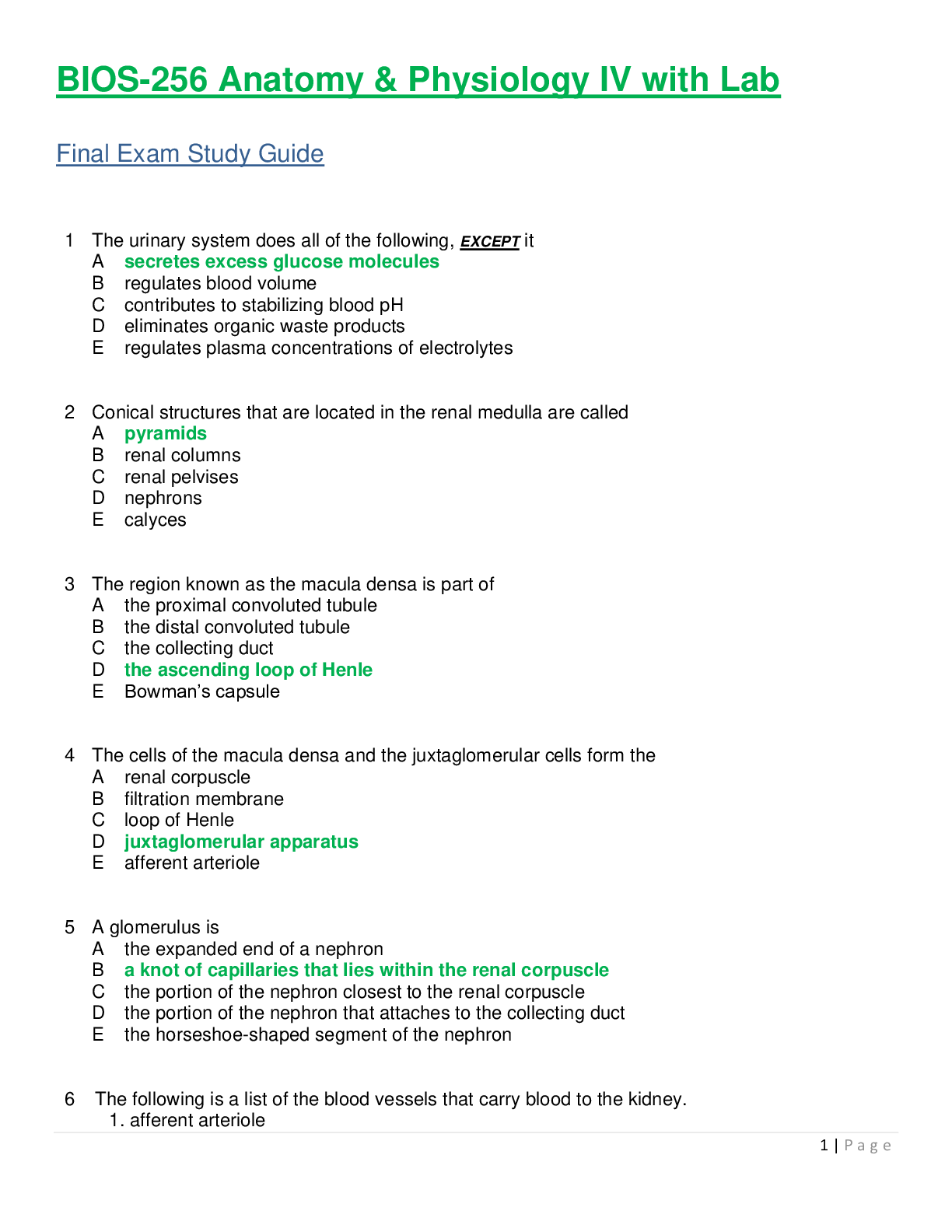

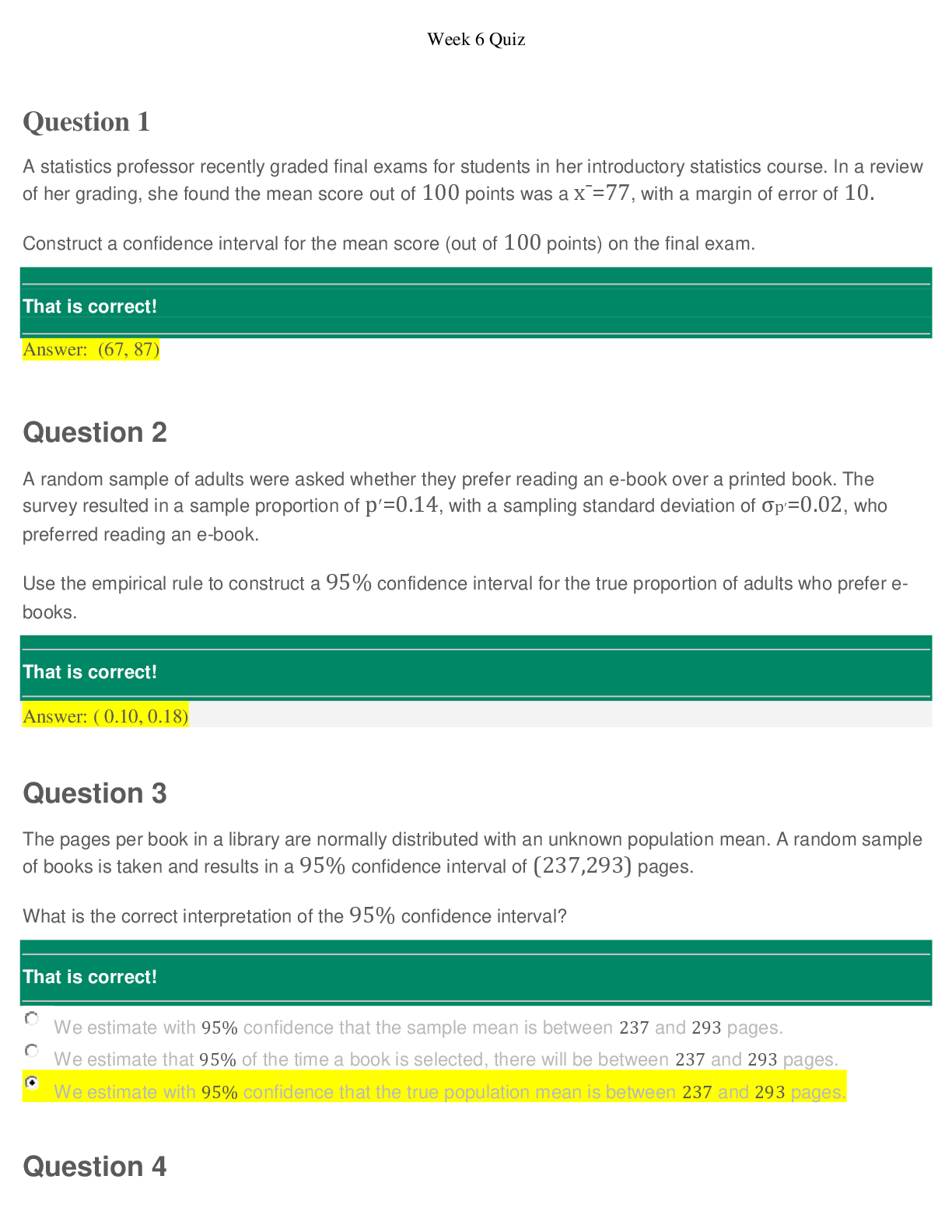



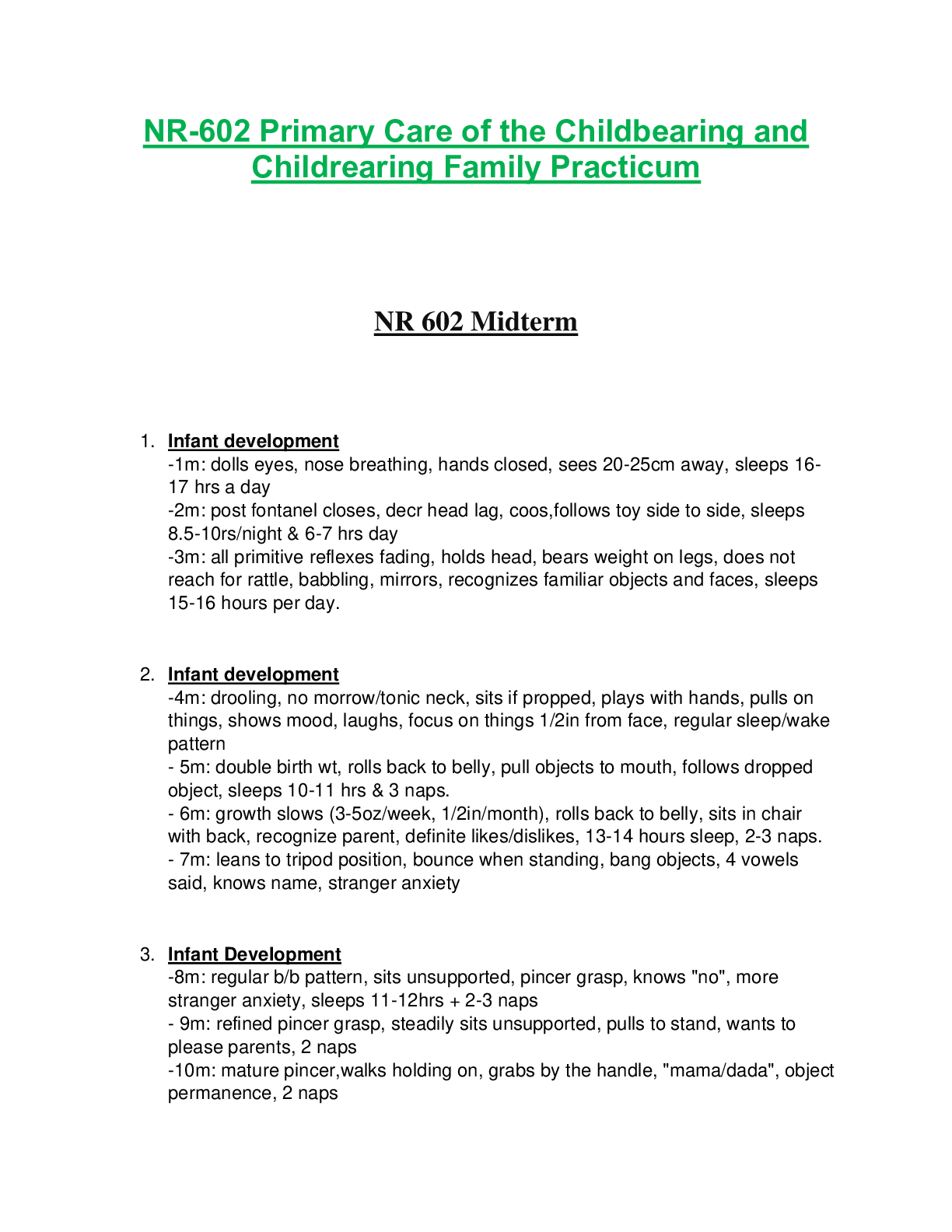
 – Chamberlain College of Nursing.png)

